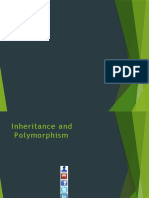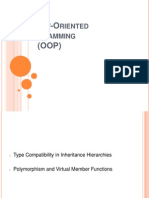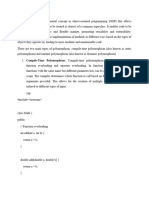0% found this document useful (0 votes)
12 views2 pagesPolymorphism
Polymorphism allows classes related by inheritance to perform actions in different ways, utilizing overridden methods from derived classes. For example, a base class 'Animal' can have derived classes like 'Pig' and 'Dog', each implementing their own version of the 'animalSound()' method. This concept promotes code reusability by enabling new classes to inherit and reuse attributes and methods from existing classes.
Uploaded by
santoshCopyright
© © All Rights Reserved
We take content rights seriously. If you suspect this is your content, claim it here.
Available Formats
Download as TXT, PDF, TXT or read online on Scribd
0% found this document useful (0 votes)
12 views2 pagesPolymorphism
Polymorphism allows classes related by inheritance to perform actions in different ways, utilizing overridden methods from derived classes. For example, a base class 'Animal' can have derived classes like 'Pig' and 'Dog', each implementing their own version of the 'animalSound()' method. This concept promotes code reusability by enabling new classes to inherit and reuse attributes and methods from existing classes.
Uploaded by
santoshCopyright
© © All Rights Reserved
We take content rights seriously. If you suspect this is your content, claim it here.
Available Formats
Download as TXT, PDF, TXT or read online on Scribd
/ 2


























































